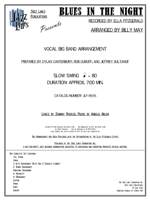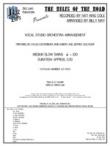BLUES IN THE NIGHT
Recorded by Ella Fitzgerald
Arranged by Billy May, Prepared by Dylan Canterbury, Rob DuBoff, and Jeffrey Sultanof

Cat #: JLP-9656
$65.00This item usually ships within 1 business day.
Questions?
Please call +1-518-587-1102 or email us.
Edition: Jazz Big Band Arrangement with Vocal
Description: Swing - Medium Difficult
Publisher: Jazz Lines Publications
Recorded in 1961, this Billy May arrangement for Ella Fitzgerald of "Blues In The Night" differs substantially from Marty Paich's earlier little big band version (available as JLP-9591) not only in instrumentation, but overall atmosphere and intensity.
The arrangement begins with a moody semi-deconstruction of the main melody played by essentially two groups-within-a-group. The first group consists of two trumpets and two trombones handling a unison line. The second consists of a clarinet, four saxophones, and one trumpet, and provides some highly Ellington-esque "train whistle" interjections behind the other group. These two groups continue to play these roles once the vocalist enters with the main melody at measure 13.
Although the ensemble groupings become much more traditional beginning at measure 37, May finds a new way to keep things interesting with some new tricks beginning at measure 55. These tricks involve slipping and sliding back and forth between the initially established slow swing tempo and a double time feel, with the arrangement even occasionally implying double time without actually shifting gears. This ensemble portion should be thoroughly excitable and even bombastic at times, and the vocalist's performance should reflect this accordingly.
A simple but effective ensemble shout section at measure 67 sets up an alto saxophone solo (performed by the incomparable Benny Carter on the original recording) at measure 79 accompanied by the initial melody variation in the trumpets and trombones. May begins to play around with the time again at the vocalist's re-entrance at measure 91 before the final A section recaps the previous ensemble blast from measure 55.
After a rubato solo vocal break, the ending returns once again to the initial melody variation as played by the trumpets and trombones, with an alto saxophone solo over top of the proceedings. The original parts have an indication as to what ended up happening on the recording: a gradual studio fade out. The parts also contained what appears to be an optional ending for live performances, which we have chosen to include for the sake of practical execution purposes.
This arrangement is for big band with female vocalist. It is not a transcription - it has been prepared from Billy May's original score and the set parts used during the recording session. The vocal key is Eb throughout and alto saxophone 2 doubles on clarinet.
Vocal
2 Alto Saxophones (Alto Sax 2 Doubles Clarinet)
2 Tenor Saxophones
Baritone Saxophone
4 Trumpets
4 Trombones
Guitar
Piano
Bass
Drums
Trumpet 1: C6
Trombone 1: Bb4









